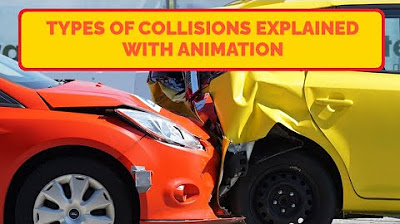Elastic and Inelastic Collisions
Summary
TLDRProfessor Dave explains collisions by highlighting conservation of linear momentum and contrasting elastic and inelastic interactions. Elastic collisions—like billiard balls or ideal-gas molecules—preserve both momentum and kinetic energy, while inelastic collisions (including perfectly inelastic cases) convert kinetic energy into heat, sound, and deformation even though momentum remains conserved. Examples range from soccer kicks to car crashes and asteroid fusion during planet formation. Real collisions fall between the two extremes, but treating them as nearly elastic or perfectly inelastic simplifies analysis and yields accurate predictions. The lesson closes the unit on linear motion and transitions toward circular motion, with a brief call to subscribe and support the channel.
Takeaways
- 😀 Collisions occur when moving objects come into contact with each other, and this concept applies to both small (molecules) and large (celestial bodies) objects.
- 😀 The principle of conservation of linear momentum holds in all collisions, but how this manifests depends on the type of collision.
- 😀 In elastic collisions, total kinetic energy and momentum are conserved, with objects bouncing off each other without energy loss.
- 😀 Perfectly elastic collisions can be approximated in cases like atoms in an ideal gas or balls on a pool table.
- 😀 Nearly elastic collisions, like when a soccer player kicks a ball, result in minimal energy loss to heat and sound.
- 😀 Perfectly inelastic collisions involve two objects sticking together after the collision, moving as a single mass.
- 😀 The formation of planets, including Earth, involves numerous inelastic collisions where celestial bodies fuse together.
- 😀 In perfectly inelastic collisions, momentum is conserved but kinetic energy is not, with much of the energy converted to heat, sound, and internal energy.
- 😀 In real-world collisions, no event is completely elastic or perfectly inelastic; they usually fall somewhere in between.
- 😀 For simplicity in calculations and predictions, collisions can be approximated as either perfectly elastic or perfectly inelastic, depending on the situation.
Q & A
What is a collision?
-A collision occurs when an object in motion comes into contact with another object. This concept applies to various objects, from pool balls to celestial bodies like asteroids and planets.
What principle is always conserved during a collision?
-The conservation of linear momentum is always upheld during a collision.
What distinguishes an elastic collision from other types?
-In an elastic collision, both total kinetic energy and momentum are conserved, and the objects involved bounce off without losing energy.
Can you give an example of an elastic collision?
-An example of an elastic collision is when billiard balls collide on a pool table. The balls remain separate after the collision and no kinetic energy is lost.
What are nearly elastic collisions, and do they exist in real life?
-Nearly elastic collisions occur when some kinetic energy is lost, such as when a soccer player kicks a ball. While the objects remain separate, some energy is converted into heat and sound.
What happens in a perfectly inelastic collision?
-In a perfectly inelastic collision, two objects collide and move together as one mass. An example is when two celestial bodies collide and fuse to form a larger body.
How is momentum analyzed in perfectly inelastic collisions?
-In perfectly inelastic collisions, momentum can be analyzed by treating the two objects as one combined object after the collision. The total momentum equals the sum of the individual momenta.
Are total kinetic energy and total momentum conserved in inelastic collisions?
-In inelastic collisions, total momentum is conserved, but total kinetic energy is not. Some energy is converted into sound, heat, and internal energy.
What happens to kinetic energy during an inelastic collision?
-During an inelastic collision, part of the kinetic energy is converted into other forms of energy, such as sound and heat, causing the objects to deform.
Can all collisions be classified as either elastic or perfectly inelastic?
-No, in reality, no collision is completely elastic or perfectly inelastic. Most collisions fall somewhere in between, which we label as inelastic, meaning some kinetic energy is lost, but not completely.
Outlines

此内容仅限付费用户访问。 请升级后访问。
立即升级Mindmap

此内容仅限付费用户访问。 请升级后访问。
立即升级Keywords

此内容仅限付费用户访问。 请升级后访问。
立即升级Highlights

此内容仅限付费用户访问。 请升级后访问。
立即升级Transcripts

此内容仅限付费用户访问。 请升级后访问。
立即升级浏览更多相关视频

Types of Collisions explained with animation

Tumbukan 1 Dimensi

Elastic and Inelastic Collisions

Physics 10 Momentum and Impulse (5 of 30) Why you Don't Want to Collide with a Semi Truck

FISIKA SMA/SMK, TUMBUKAN LENTING SEMPURNA, LENTING SEBAGIAN, TIDAK LENTING SAMA SEKALI

Conservation of Momentum | Elastic and Inelastic Collision | Grade 9 Science Quarter 4 Week 4
5.0 / 5 (0 votes)
